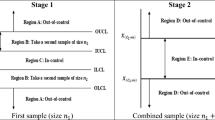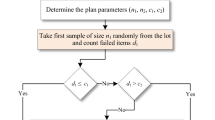Abstract
In this paper, six new \(({k}_{1},{k}_{2},\dots ,{k}_{m})\)-runs with multi-state trials are proposed creatively, which can satisfy the practical needs in many fields. The exact distributions of proposed runs are obtained by applying finite Markov chain imbedding approach. This paper not only studies the case of independent identical distribution (i.i.d.) multi-state trials, but also independent non-identical distribution (non-i.i.d.) multi-state trials. Numerical examples have served the purpose to illustrate the effectiveness of the proposed approach. This study is of reference value and application significance for similar runs.
Similar content being viewed by others
References
Balakrishnan N, Koutras MV (2002) Runs and scans with applications. Wiley, New York
Balakrishnan N, Koutras MV, Milienos FS (2014) Start-up demonstration tests: models, methods and applications, with some unifications. Appl Stoch Model Bus 30(4):373–413
Balakrishnan N, Paroissin C, Turlot JC (2015) One-sided control charts based on precedence and weighted precedence statistics. Qual Reliab Eng Int 31(1):113–134
Balakrishnan N, Stepanov A (2013) Runs based on records: their distributional properties and an application to testing for dispersive ordering. Methodol Comput Appl 15(3):583–594
Dafnis SD, Antzoulakos DL, Philippou AN (2010) Distributions related to (k(1), k(2)) events. J Stat Plan Infer 140(7):1691–1700
Dafnis SD, Makri FS, Koutras MV (2020) Generalizations of runs and patterns distributions for sequences of binary trials. Methodol Comput Appl. https://doi.org/10.1007/s11009-020-09810-0
Eryilmaz S (2008) Distribution of runs in a sequence of exchangeable multi-state trials. Stat Probabil Lett 78(12):1505–1513
Eryilmaz S (2016) Generalized waiting time distributions associated with runs. Metrika 79(3):357–368
Eryilmaz S, Mahmoud B (2012) Linear m-consecutive-k, l-out-of-n: F system. IEEE T Reliab 61(3):787–791
Fu JC (1996) Distribution Theory of runs and patterns associated with a sequence of multi-state trials. Stat Sinica 6(4):957–974
Fu JC, Koutras MV (1994) Distribution-theory of runs - a Markov-chain approach. J Am Stat Assoc 89(427):1050–1058
Gong M, Xie M, Yang YN (2018) Reliability assessment of system under a generalized run shock model. J Appl Probab 55(4):1249–1260
Han Q, Aki S (1999) Joint distributions of runs in a sequence of multi-state trials. Ann I Stat Math 51(3):419–447
Huang WT, Tsai CS (1991) On a modified binomial distribution of order k. Stat Probabil Lett 11(2):125–131
Koutras MV, Eryilmaz S (2017) Compound geometric distribution of order k. Methodol Comput Appl 19(2):377–393
Kumar AN, Upadhye NS (2017) On perturbations of Stein operator. Commun Stat-Theor M 46(18):9284–9302
Kumar AN, Upadhye NS (2019) Generalizations of distributions related to (k1,k2)-runs. Metrika 82(2): 249-268
Makri FS, Psillakis ZM (2012) Counting certain binary strings. J Stat Plan Infer 142(4):908–924
Ozkut M, Eryilmaz S (2019) Reliability analysis under Marshall-Olkin run shock model. J Comput Appl Math 349:52–59
Philippou AN, Georghiou C, Philippou GN (1983) A generalized geometric distribution and some of its properties. Stat Probabil Lett 1:171–175
Shinde RL, Kotwal KS (2006) On the joint distribution of runs in the sequence of Markov-dependent multi-state trials. Stat Probabil Lett 76(10):1065–1074
Upadhye NS, Kumar AN (2018) Pseudo-binomial approximation to (k(1), k(2))-runs. Stat Probabil Lett 141:19–30
Vellaisamy P (2004) Poisson approximation for (k(1), k(2))-events via the Stein-Chen method. J Appl Probab 41(4):1081–1092
Wang XY, Zhao X, Sun JL (2019) A compound negative binomial distribution with mutative termination conditions based on a change point. J Comput Appl Math 351:237–249
Wang XY, Zhao X, Wang SQ, Sun LP (2020) Reliability and maintenance for performance-balanced systems operating in a shock environment. Reliab Eng Syst Saf 195. https://doi.org/10.1016/j.ress.2019.106705
Wang XY, Zhao X, Wu CS, Wang SQ (2022) Mixed shock model for multi-state weighted k-out-of-n: F systems with degraded resistance against shocks. Reliab Eng Syst Saf 217. https://doi.org/10.1016/j.ress.2021.108098
Yalcin F, Eryilmaz S (2014) q-geometric and q-binomial distributions of order k. J Comput Appl Math 271:31–38
Zhao X, Guo XX, Wang XY (2018) Reliability and maintenance policies for a two-stage shock model with self-healing mechanism. Reliab Eng Syst Saf 172:185–194
Zhao X, Wang SQ, Wang XY, Fan Y (2020) Multi-state balanced systems in a shock environment. Reliab Eng Syst Saf 193. https://doi.org/10.1016/j.ress.2019.106592
Zhao X, Wang XY, Coit DW, Chen Y (2019) Start-up demonstration tests with the intent of equipment classification for balanced systems. IEEE T Reliab 68(1):161–174
Acknowledgements
The authors would also like to thank Mr. Leping Sun for his contribution of this paper.
Funding
This work is supported by National Natural Science Foundation of China (Grant Nos. 72001006, 72131002 and 71971026), Beijing Social Science Foundation (Grant No. 20GLC052) and Science and Technology Funding program for Innovative Talents of Beijing Institute of Technology Technological Innovation Program (2021CX01022).
Author information
Authors and Affiliations
Corresponding author
Additional information
Publisher's Note
Springer Nature remains neutral with regard to jurisdictional claims in published maps and institutional affiliations.
Appendix
Appendix
-
A
Example for distribution of \({A}_{{k}_{1},{k}_{2},{k}_{3}}^{(n)}\)
For the case \(n=5,{k}_{1}={k}_{2}=2,{k}_{3}=1\), the corresponding matrix \({\Lambda }_{r}={\Lambda }_{r}({A}_{\mathrm{2,2},1}^{(5)})\) is given by
$$\begin{array}{c}(0,N,N,0)\\ (0,Y,N,0)\\ (0,N,N,1)\\ (0,Y,N,1)\\ (0,Y,Y,0)\\ {E}_{a}\end{array}\left[\begin{array}{cccccc}{p}_{2,r}+{p}_{3,r}& 0& {p}_{1,r}& 0& 0& 0\\ {p}_{3,r}& {p}_{1,r}& 0& {p}_{2,r}& 0& 0\\ {p}_{2,r}+{p}_{3,r}& {p}_{1,r}& 0& 0& 0& 0\\ {p}_{3,r}& 0& {p}_{1,r}& 0& {p}_{2,r}& 0\\ 0& 0& {p}_{1,r}& 0& {p}_{2,r}& {p}_{3,r}\\ 0& 0& 0& 0& 0& 1\end{array}\right].$$ -
B
Example for distribution of \({B}_{{k}_{1},{k}_{2},{k}_{3}}^{(n)}\)
For the case \(n=6,{k}_{1}={k}_{2}=2\text{, }{k}_{3}=1\), the corresponding matrix \({\Lambda }_{r}={\Lambda }_{r}({B}_{\mathrm{2,2},1}^{(6)})\) is gotten by
$$\begin{array}{c}(0,N,N,0)\\ (0,N,N,1)\\ (0,Y,N,0)\\ (0,Y,N,1)\\ (0,Y,N,-1)\\ (0,Y,Y,0)\\ (0,Y,Y,-1)\\ (1,N,N,0)\\ {E}_{a}\end{array}\left[\begin{array}{ccccccccc}{p}_{2,r}+{p}_{3,r}& {p}_{1,r}& 0& 0& 0& 0& 0& 0& 0\\ {p}_{2,r}+{p}_{3,r}& 0& {p}_{1,r}& 0& 0& 0& 0& 0& 0\\ {p}_{3,r}& 0& 0& {p}_{2,r}& {p}_{1,r}& 0& 0& 0& 0\\ {p}_{3,r}& {p}_{1,r}& 0& 0& 0& {p}_{2,r}& 0& 0& 0\\ {p}_{2,r}+{p}_{3,r}& 0& 0& 0& {p}_{1,r}& 0& 0& 0& 0\\ 0& {p}_{1,r}& 0& 0& 0& 0& {p}_{2,r}& {p}_{3,r}& 0\\ {p}_{3,r}& {p}_{1,r}& 0& 0& 0& 0& {p}_{2,r}& 0& 0\\ 0& 0& 0& 0& 0& 0& 0& {p}_{2,r}+{p}_{3,r}& {p}_{1,r}\\ 0& 0& 0& 0& 0& 0& 0& 0& 1\end{array}\right].$$ -
C
Example for distribution of \({C}_{{k}_{1},{k}_{2},{k}_{3}}^{(n)}\)
For the case \(n=5,{k}_{1}={k}_{2}={k}_{3}=2\), the corresponding matrix \({\Lambda }_{r}={\Lambda }_{r}({C}_{\mathrm{2,2},2}^{(5)})\) is built as
$$\begin{array}{c}(0,N,\mathrm{0,0})\\ (0,N,\mathrm{1,0})\\ (0,Y,\mathrm{0,0})\\ (0,Y,\mathrm{0,1})\\ (0,Y,\mathrm{1,0})\\ (1,N,\mathrm{0,0})\\ {E}_{a}\end{array}\left[\begin{array}{ccccccc}{p}_{2,r}+{p}_{3,r}& {p}_{1,r}& 0& 0& 0& 0& 0\\ {p}_{2,r}+{p}_{3,r}& 0& {p}_{1,r}& 0& 0& 0& 0\\ 0& 0& {p}_{1,r}& {p}_{3,r}& {p}_{2,r}& 0& 0\\ {p}_{2,r}& {p}_{1,r}& 0& 0& 0& {p}_{3,r}& 0\\ {p}_{3,r}& {p}_{1,r}& 0& 0& 0& {p}_{2,r}& 0\\ 0& 0& 0& 0& 0& {p}_{2,r}+{p}_{3,r}& {p}_{1,r}\\ 0& 0& 0& 0& 0& 0& 1\end{array}\right].$$ -
D
Example for distribution of \({D}_{{k}_{1},{k}_{2},{k}_{3}}^{(n)}\)
For the case \(n=5,{k}_{1}={k}_{2}={k}_{3}=2\), the corresponding matrix \({\Lambda }_{r}={\Lambda }_{r}({D}_{\mathrm{2,2},2}^{(5)})\) is gained as
$$\begin{array}{c}(0,N,N,\mathrm{0,0})\\ (0,N,N,\mathrm{0,1})\\ (0,N,N,\mathrm{1,0})\\ (0,N,Y,\mathrm{0,0})\\ (0,N,Y,\mathrm{1,0})\\ (0,Y,N,\mathrm{0,0})\\ (0,Y,N,\mathrm{1,0})\\ (1,N,N,\mathrm{0,0})\\ {E}_{a}\end{array}\left[\begin{array}{ccccccccc}{p}_{3,r}& {p}_{2,r}& {p}_{1,r}& 0& 0& 0& 0& 0& 0\\ {p}_{3,r}& 0& {p}_{1,r}& {p}_{2,r}& 0& 0& 0& 0& 0\\ {p}_{3,r}& {p}_{2,r}& 0& 0& 0& {p}_{1,r}& 0& 0& 0\\ 0& 0& {p}_{1,r}& {p}_{2,r}& {p}_{3,r}& 0& 0& 0& 0\\ 0& {p}_{2,r}& {p}_{1,r}& 0& 0& 0& 0& {p}_{3,r}& 0\\ 0& {p}_{2,r}& 0& 0& 0& {p}_{1,r}& {p}_{3,r}& 0& 0\\ 0& {p}_{2,r}& {p}_{1,r}& 0& 0& 0& 0& {p}_{3,r}& 0\\ 0& 0& 0& 0& 0& 0& 0& {p}_{3,r}& {p}_{1,r}\text{+}{p}_{2,r}\\ 0& 0& 0& 0& 0& 0& 0& 0& 1\end{array}\right].$$ -
E
Example for distribution of \({E}_{{k}_{1},{k}_{2},{k}_{3}}^{(n)}\)
For the case \(n=5,{k}_{1}={k}_{2}={k}_{3}=2\), the corresponding matrix \({\Lambda }_{r}={\Lambda }_{r}({E}_{\mathrm{2,2},2}^{(5)})\) is derived as
$$\begin{array}{c}(0,N,\mathrm{0,0})\\ (0,N,\mathrm{1,0})\\ (0,Y,\mathrm{0,0})\\ (0,Y,\mathrm{0,1})\\ (0,Y,\mathrm{1,0})\\ (0,Y,-\mathrm{1,0})\\ (1,N,\mathrm{0,0})\\ {E}_{a}\end{array}\left[\begin{array}{cccccccc}{p}_{2,r}+{p}_{3,r}& {p}_{1,r}& 0& 0& 0& 0& 0& 0\\ {p}_{2,r}+{p}_{3,r}& 0& {p}_{1,r}& 0& 0& 0& 0& 0\\ 0& 0& 0& {p}_{3,r}& {p}_{2,r}& {p}_{1,r}& 0& 0\\ {p}_{2,r}& {p}_{1,r}& 0& 0& 0& 0& {p}_{3,r}& 0\\ {p}_{3,r}& {p}_{1,r}& 0& 0& 0& 0& {p}_{2,r}& 0\\ {p}_{2,r}+{p}_{3,r}& 0& 0& 0& 0& {p}_{1,r}& 0& 0\\ 0& 0& 0& 0& 0& 0& {p}_{2,r}+{p}_{3,r}& {p}_{1,r}\\ 0& 0& 0& 0& 0& 0& 0& 1\end{array}\right].$$ -
F
Example for distribution of \({F}_{{k}_{1},{k}_{2},{k}_{3}}^{(n)}\)
For the case \(n=5,{k}_{1}={k}_{2}={k}_{3}=2\), the corresponding matrix \({\Lambda }_{r}={\Lambda }_{r}({F}_{\mathrm{2,2},2}^{(5)})\) is obtained as
Rights and permissions
About this article
Cite this article
Zhao, X., Song, Y., Wang, X. et al. Distributions of \(({k}_{1},{k}_{2},\dots ,{k}_{m})\)-runs with Multi-state Trials. Methodol Comput Appl Probab 24, 2689–2702 (2022). https://doi.org/10.1007/s11009-022-09948-z
Received:
Revised:
Accepted:
Published:
Issue Date:
DOI: https://doi.org/10.1007/s11009-022-09948-z




